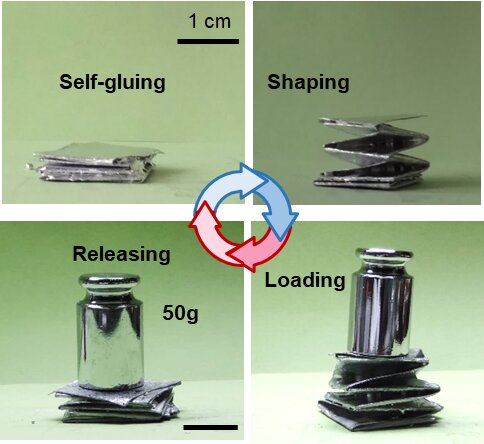Researchers in Beijing, China have discovered a groundbreaking technique for transforming everyday materials like paper and plastic into electronic “smart devices” using liquid metal. The study, published in the journal Cell Reports Physical Science, outlines a simple process for applying liquid metal to surfaces that typically do not bond with it. The new method could pave the way for wearable testing platforms, flexible devices, and soft robotics on a large scale.
“Before, we thought that it was impossible for liquid metal to adhere to non-wetting surfaces so easily, but here it can adhere to various surfaces only by adjusting the pressure, which is very interesting,” said Bo Yuan, the lead scientist at Tsinghua University.
Research has long been impeded by liquid metal’s high surface tension, which hinders it from binding with standard materials like paper. Previous studies necessitated methods like “transfer printing” that involve additional materials to bind with the liquid metal, which can be counterproductive by complicating the process, reducing performance, and affecting electrical, thermal, or mechanical functionality.
This study examined direct printing liquid metal onto different substrates without compromising its properties by rubbing it against silicone and silicone polymer stamps initially coated with two types of liquid metal, eGaln and BilnSn. The team then applied varying degrees of force to the stamps onto a paper surface, discovering that applying a small amount of force resulted in the metal droplets adhering uniformly to the surface. Furthermore, larger force prevented the droplets from remaining in place.
Afterwards, the team folded the metal-coated paper into an Origami structure to demonstrate that the surface could be folded as usual without losing its standard properties.
Although promising, researchers are still figuring out how to ensure that the liquid metal coating remains in place after application. Currently, a protective layer can be added, but the team expects to find a solution without having to do so.
“We plan to construct smart devices using materials treated by this method,” said Yuan. Moreover, the team aims to expand the method to include more surfaces, such as metal and ceramic.
More information:
Hongzhang Wang, Direct Fabrication of Liquid Metal Multifunctional Paper Based on Force responsive Adhesion, Cell Reports Physical Science (2023). DOI: 10.1016/j.xcrp.2023.101419. www.cell.com/cell-reports-phys … 2666-3864(23)00193-5
Citation:
Liquid metal sticks to surfaces without a binding agent (2023, June 9)
retrieved 9 June 2023
from https://phys.org/news/2023-06-liquid-metal-surfaces-agent.html
This document is subject to copyright. Apart from any fair dealing for the purpose of private study or research, no part may be reproduced without the written permission. The content is provided for information purposes only.
Denial of responsibility! TechCodex is an automatic aggregator of the all world’s media. In each content, the hyperlink to the primary source is specified. All trademarks belong to their rightful owners, and all materials to their authors. For any complaint, please reach us at – [email protected]. We will take necessary action within 24 hours.

Jessica Irvine is a tech enthusiast specializing in gadgets. From smart home devices to cutting-edge electronics, Jessica explores the world of consumer tech, offering readers comprehensive reviews, hands-on experiences, and expert insights into the coolest and most innovative gadgets on the market.


